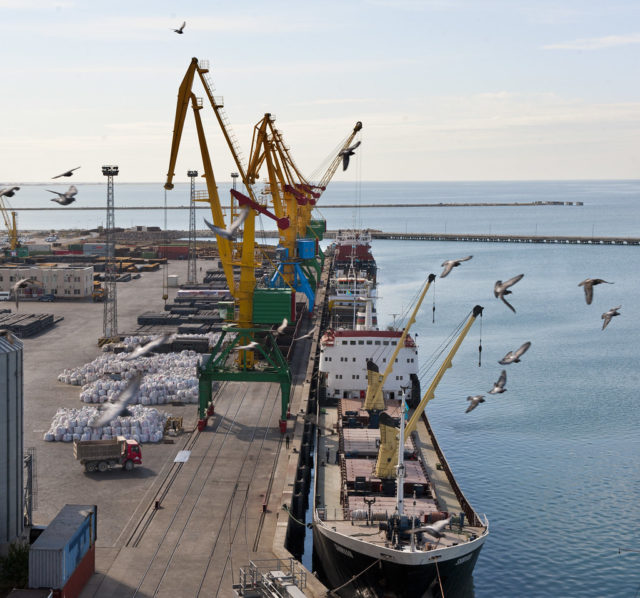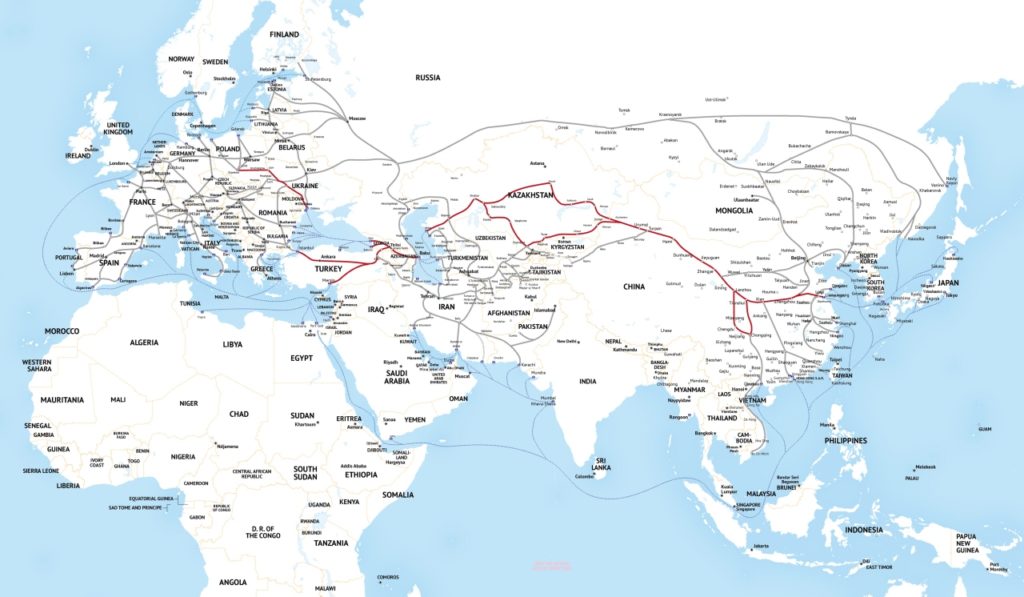
Middle Corridor: Potential Alternative to Russian Railways?
Publication: Eurasia Daily Monitor Volume: 19 Issue: 56
By:

The Russo-Ukrainian war has cast doubt on the sustainability of the Chinese Belt and Road Initiative’s (BRI) “Northern Corridor” because of mounting Western sanctions on this overland route’s key links—Russia and Belarus (see EDM, April 8, 18). The growing vulnerability of the Northern Corridor, which carries the bulk of railway trade between China and the European Union, has led to new discussions about potential alternatives, particularly the so-called “Middle Corridor,” which traverses Central Asia and the South Caucasus, entirely bypassing Russian territory (AzerNews, March 17; Rail Turkey, March 22).
First, an early March 2022 agreement between Georgia, Azerbaijan and Kazakhstan on the development of the Trans-Caspian International Transport Route (TITR) is especially noteworthy because it calls for establishing a “Eurasian Rail Alliance.” This tripartite joint venture will be tasked with unifying regulations and reducing tariffs for transit cargos (Silk Road Briefing, March 10; APA, March 11). Second, a quadrilateral declaration signed by Georgia, Azerbaijan, Turkey and Kazakhstan on the Middle Corridor highlights the importance these governments place in steps aimed at strengthening their countries’ transit potential as well as increasing the competitiveness of the corridor versus other routes (Agenda.ge, March 31). The discussion of both agreements amidst the Russo-Ukrainian war highlights the Eurasian transit states’ desire to attract international shipping companies to the Middle Corridor and to strengthen their position in the context of Chinese-EU overland trade relations.

However, despite these developments, a series of political, economic and technical challenges hamper the possibility that the Middle Corridor could entirely replace the Northern Corridor via Russia and Belarus, at least in the short and medium term. In terms of political challenges, the lack of support from both the Chinese government and the EU, in comparison with the Northern Corridor, slows down the development of the Middle Corridor. At the same time, greater Chinese involvement and support for the Middle Corridor, which bypasses the territory of Russia, would likely be perceived by Moscow as an unfriendly and opportunistic policy at this time (see EDM, March 21). The non-Russian transcontinental route’s future, therefore, is even more strongly dependent on the policies of the transit countries.
In addition to political challenges, economic problems also limit the Middle Corridor’s potential as an alternative to transit via Russian railways. The first problem is the cost of sending cargo through this more southerly route. While the cost of cargo delivery across the Northern Corridor (through China, Kazakhstan, Russia and Belarus) is approximately 2,467 euros ($2,662) per twenty-foot equivalent unit (TEU), the cost of cargo delivery via the Middle Corridor (China–Kazakhstan–Caspian Sea–Azerbaijan–Georgia–Turkey or the Black Sea–Europe) starts at 5,000 euros (almost $5,400) per TEU (Utlc.com, November 12, 2020; Vzglyad, February 27, 2016). Relatedly, the lack of subsidization from Chinese prefectures and provinces discourages Eurasian and Chinese companies from using the more expensive Middle Corridor to send their products to the EU market (Osw.waw.pl, February 28, 2018).
Moreover, despite the Middle Corridor being physically the shortest path between China and Europe, travel time along this route still compares unfavorably with the Northern Corridor. While cargos reach their destination via the northern route in approximately 5–6 days, the Middle Corridor requires about 20–25 days’ transit (Utlc.com, November 12, 2020; Adycontainer.com, accessed April 19, 2022).
The second problem is an unfriendly business environment in most of the transit countries, especially Kazakhstan. In particular, inefficient border controls in Central Asian states increase the informal cost of cargo by lengthening wait times, thus disincentivizing both Chinese and European companies from using the corridor (Tengrinews.kz, January 11).
The final but most important challenges relate to the technical limitations of the Middle Corridor. In terms of hard infrastructure, capacity problems are a significant bottleneck. Despite the fact that in 2021, the volume of freight transport on the Middle Corridor increased by 101 percent year-on-year, there are huge capacity differences between the Northern and Middle corridors. For example, the volume of cargo sent along the northern routes, via Russia, has reached approximately 1.5 million TEUs per year; whereas the capacity available on the Middle Corridor is estimated at 2–3 percent of that amount (RailFreight.com, March 18).
The second problem pertains to the repeat unloading and reloading processes involved with the multimodal Middle Corridor. Congestion issues at the Caspian and Black Sea ports and changeable weather conditions there cause time-consuming delays, which compound uncertainty when it comes to schedule management and arrival time calculations. Furthermore, crossing the Caspian Sea is a major bottleneck in and of itself, as ferry and port services are insufficient to balance rail capacities on both sides (Osw.waw.pl, February 28, 2018).
In addition to the problems with the sea route, there are also hindrances to transit along the overland route across Turkey. The partially unsignalized, single-track rail line from Georgia to Istanbul (which presently can carry only six cargo trains per direction per day) and the limited capacities within the Greater Istanbul area—especially at Gezbe station on the Asian side and Halkalı station on the European side—fall woefully short of the 40 full trains per day that can travel along the Northern Corridor (Rail Turkey, September 9, 2019 and March 22, 2022).
Finally, underdeveloped soft infrastructure also slows the transportation process through the Middle Corridor. These include, first and foremost, weak customs and border management, the absence of unified regulations and technical standards, and a lack of digitalization. These issues cause not only delays but also serious fraud at border checkpoints (Osw.waw.pl, February 28, 2018).
To sum up, in terms of political, economic and technical challenges, the Middle Corridor cannot fully take over as an alternative to the northern route in the short-to-medium term; but it could play an increasingly important complementary role when it comes to overland transcontinental trade. In the long run, Middle Corridor countries will need to cooperate more closely with both EU member states and Chinese provinces to attract needed investment in both hard infrastructure (to solve physical bottlenecks) and soft infrastructure (to help reduce costs and optimize time management along this corridor). Much work remains ahead.



